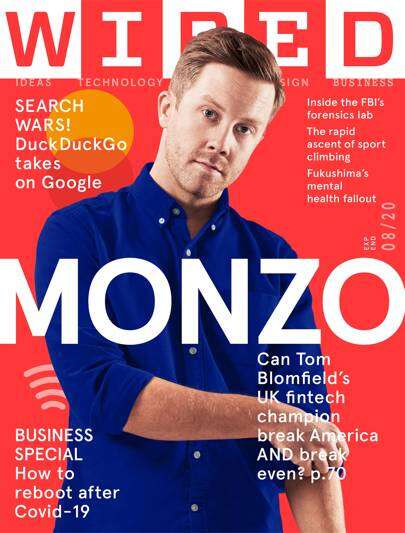
Wired magazine is forecasting revenue growth of up to 10% this year, despite the coronavirus (Covid-19) crisis, as the Conde Nast brand has seen a “huge appetite” from readers and advertisers during the pandemic.
Wired UK editor-in-chief Greg Williams (pictured, right) and publishing director Nick Sargent (pictured, left) spoke to Press Gazette about how they have responded to the crisis brought on by the virus.
They put the huge demand they have seen down to Wired’s editorial focus on what’s coming next and how the world is going to change – making it particularly relevant in these uncertain times. Its main sections are technology, science, politics, business and culture.
Scroll down for full video interview
Williams, who became editor in 2017 after seven years as deputy, helped reposition Wired from being perceived as a magazine about gadgets to, as Sargent put it, “competing with Bloomberg, The Economist, the Financial Times and the Washington Post”.
That is “both in terms of the editorial, the length of articles, particularly in print, and the contributors and opinions we’re getting”, he said.
He said he believed Wired would come out of the Covid-19 crisis “even stronger and even more focused as a team about what the brand means and how we deliver new innovative products to our readers”.
Wired was on the coronavirus story early in January, Williams said, leading them to shuffle editorial budgets away from some areas to double down on science, politics and business – the sections they predicted people would want to read more about as the crisis developed.
The Wired UK website’s digital audience has since “exploded”, Williams said, with traffic tripling year-on-year in March.
One story about life after lockdown in Wuhan, China received 1.8m views on Apple News alone.
“What we’re seeing is that if you do quality journalism, if you do have authority, which I think we have in this space, and there is integrity and quality to what you’re doing, then fortunately there is a big audience for that,” Williams said.
He added that this sudden growth was a “real opportunity to get what we do in front of an audience that maybe is coming to us, that hasn’t seen what we do before” and still held the view that it was only a gadgets magazine.
Print circulation could grow post-Covid
The effect on print circulation is not yet so tangible. Sargent said it was “probably as steady as a magazine can be”, although he expects some decline – like the majority of print titles – as people have been unable to go out and buy the product during lockdown.
Wired is a majority subscriber-based magazine – in 2019 it had a total average circulation of 50,033 which included 18,714 per issue and 23,731 paid subscriptions according to ABC.

July/August cover of Wired UK
And Sargent said: “If we were having a print decline and a web decline, that would be a [different] state of affairs, but our web traffic has shot up.
“Our views of our webinars have gone up, our video views are rising. So people are interacting where they can… if there is a slight drop [in circulation], which we don’t know as yet, I’m in no doubt it’ll pick up to a pre-Covid or if not higher after all this because we’ll see some migration from the website… to people buying the magazine because it’s the first time a lot of people have really interacted with it.”
Williams added that they were still “very bullish on print” and pressing ahead with plans for supplements and the annual trends guide to come later in the year. Sargent also noted the magazine is not just a replica of the website, but stands alone with a strong focus on images and design.
Holding onto events revenue
None of Conde Nast’s brands share how their revenue streams are split proportionately, but Wired’s revenue generators in order of importance are: advertising, events, magazine sales including subscriptions, consulting, affiliate, and book publishing.
Sargent said Wired’d quick pivot to virtual events helped protect revenue.
“We’ve been able to keep selling during the crisis whereas a lot of people have been trying to plug gaps, and I think that ability to develop these products has allowed us to keep going throughout the crisis,” he added.
Sargent added that they had been so “nimble” in part because of a lack of bureaucracy – he and Williams work closely together and are able to make quick decisions on how to move forward.
Two conferences were quickly postponed – Wired Health in London in March and Wired Pulse set for Vienna in May – and four new virtual platforms were created in about two and a half weeks.
They include live virtual webinars, on-demand briefings that can sit within an article page, virtual roundtables and workshops, and new digital versions of planned events. The one-day Wired Smarter conference due to be held in October will now take place online over three days.
“We went to the sponsors of our events with a solution already,” Sargent said. “What we didn’t want to happen was for them to phone up and say ‘what are you doing about this?’ and for us not to have a plan… And because we did that, I think that they were very appreciative.
“So actually we’ve kept pretty much all of the revenue from Wired Health and all our other events that we’ve either had to move or postpone, which allowed us to pivot.”
He added: “The key was to be ahead of the curve and make sure that we were providing solutions to advertisers, showing them they were getting good value, showing them they’re still getting the reach they wanted, which they took to very well… one would expect Wired to be able to pivot quickly and I think we did, and we’re very proud of what we’ve done.”
Wired UK also runs a consulting business which has taken on new clients since the pandemic began because of the brand’s ability and focus on telling people how the world is changing and what’s coming next.
Showing why diversification is key, Williams said: “If you look at the Wired business as a publishing platform, we obviously have print and online, we have a digital edition, we have video, we have podcasts, events, consulting. We’ve just signed a book with Penguin Random House for six books.
“We have these webinars, we have a now quite significant affiliates business. We have an annual trends report called Wired World. Plus we do breakfasts and dinners where we convene people together.
“So what that means is that we’ve been able to really sort of like keep all these things working at the same time and that’s how, if one thing maybe is a little bit more challenged than the other thing, we can always assume that actually something else is probably going to be growing.”
Pictures: Conde Nast
Email pged@pressgazette.co.uk to point out mistakes, provide story tips or send in a letter for publication on our "Letters Page" blog
